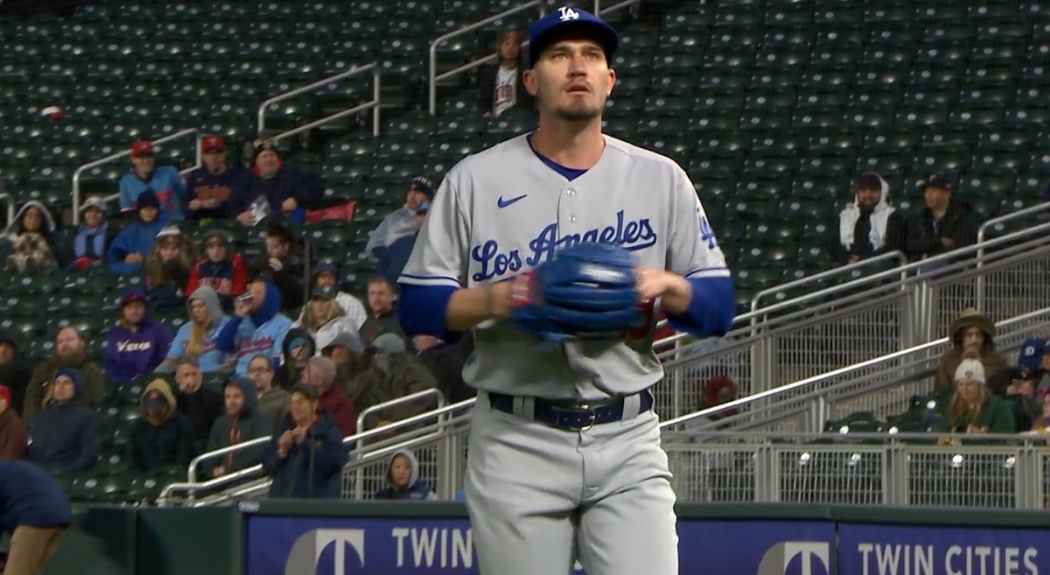When the Dodgers signed Andrew Heaney to a one-year deal before the lockout, it was viewed as a low-risk signing centered around tapping into the flashes of upside he has shown over the course of his career. As the offseason progressed, it became clear that Heaney was going to be a more important part of the Dodgers’ starting pitching plan than previously realized — in the rotation immediately as opposed to being viewed as depth — showing the team’s confidence in what they saw. If Tuesday’s outing in Minnesota is any indication, it looks like they may have been onto something.
As Fabian Ardaya of The Athletic chronicled before Tuesday’s outing, Heaney has added a “sweeper” to his pitch mix, essentially a hard slurve with a high amount of tilt. If that sounds familiar, that’s because it was the weapon Blake Treinen added on his way to a dominant 2021 season. Evan Phillips throws the pitch as well, showing an organizational pattern. Of the 21 pitchers to throw a pitch defined by online pitch tagger PitchInfo as a “sweeper” in 2022, four are Dodgers (the fourth is Walker Buehler, and it can be argued that Julio Urías, not listed, throws a version of the pitch as well).
Last season, Heaney’s breaking ball was classified as a pure curveball, a traditional offering that swept across the zone due to his low arm slot.
Heaney’s new sweeper, ironically, has less horizontal movement than the old curve. The new pitch trades that horizontal loop for more downward bite:
The pitch is also thrown about 3 mph harder than the old curve. The movement is more slider-ish, but Heaney also threw three more traditional sliders in his start against the Twins. Now more than ever, the continuum between cutter, slider, sweeper, slurve, and curveball is blurred.
Against the Twins, Heaney’s sweeper was used in a similar fashion as his curve last season: driving off the plate to lefties and towards the back foot of right-handed batters. However, the new tilt allows the pitch to dive under the barrel of the bat rather than relying on solely his arm slot to cause movement. That new tilt was on display against some of the best hitters in baseball. The new pitch has a lot more visible “finish” to it:
In 2021, the loopiness of Heaney’s curve caused significant issues for him against left-handed batters in particular (lefties slugged .600 on Heaney curves put in play last year), since the sideways loop basically lined up the break of the pitch with their swing plane. The downward tilt of the new sweeper might help to resolve that problem.
If the start against Minnesota was any indication, Heaney’s old pitch usage patterns might be out the window as well. Heaney’s breakdown in 2021 was roughly 60% fastballs, and 20% each of changes and curves to fill out the arsenal. Against Minnesota, Heaney threw more sweepers than fastballs, only three changes, and three harder sliders. Pitch mix can vary based on opposing scouting reports and weather conditions (for example, limited changeup feel in cold conditions), but it was still a dramatic difference for one game. The results certainly worked in favor of the pitch mix change: among Heaney’s career outings in which he threw at least 25 non-fastballs, the swing and miss rate against those pitches in Minnesota was the 14th-highest, and among his top 10 of the last half-decade.
——
Ultimately, Heaney’s problems in 2021 boiled down to command as much as anything else, and one start is not going to show conclusive evidence that he’s fixed those issues. However, Ardaya’s interview with Heaney reveals that the Dodgers have been trying various mechanical fixes as well, including a move to the middle of the rubber.
The Twins’ follow-up outing against Clayton Kershaw showed that the team might have deeper issues against lefty sliders, but only more outings will be able to show if Heaney’s new sweeper will continue to be this effective. So far we just have the theory of the pitch and a window into Heaney’s willingness to adjust, both of which are positive signs.
 Dodgers Digest Los Angeles Dodgers Baseball Blog
Dodgers Digest Los Angeles Dodgers Baseball Blog


